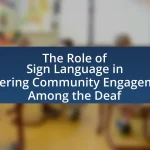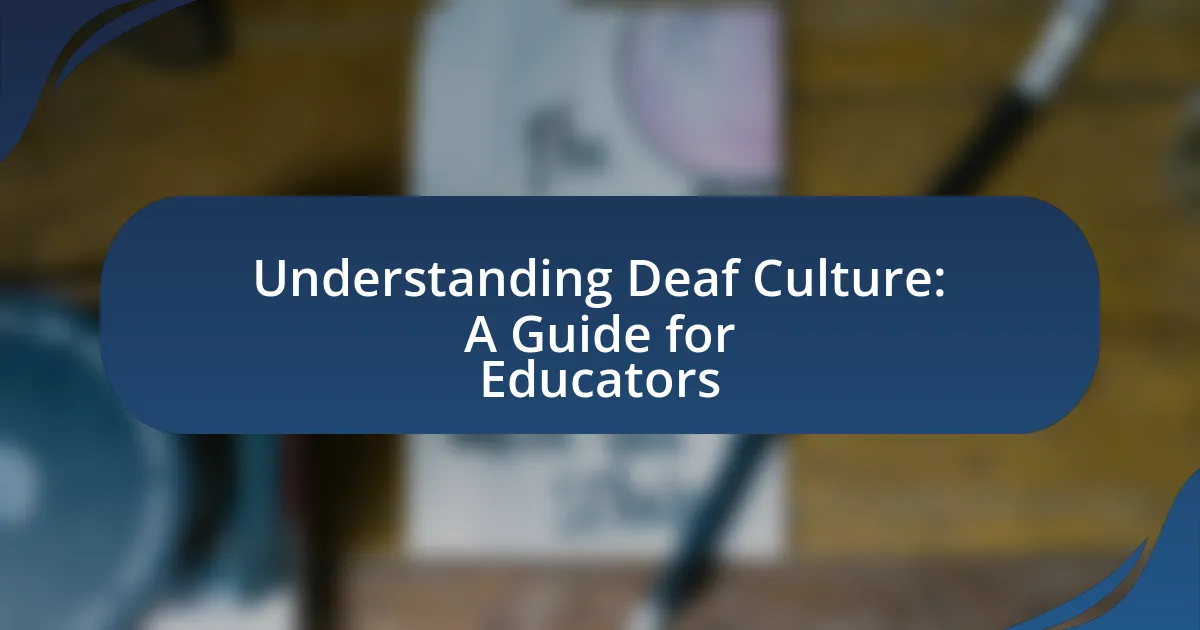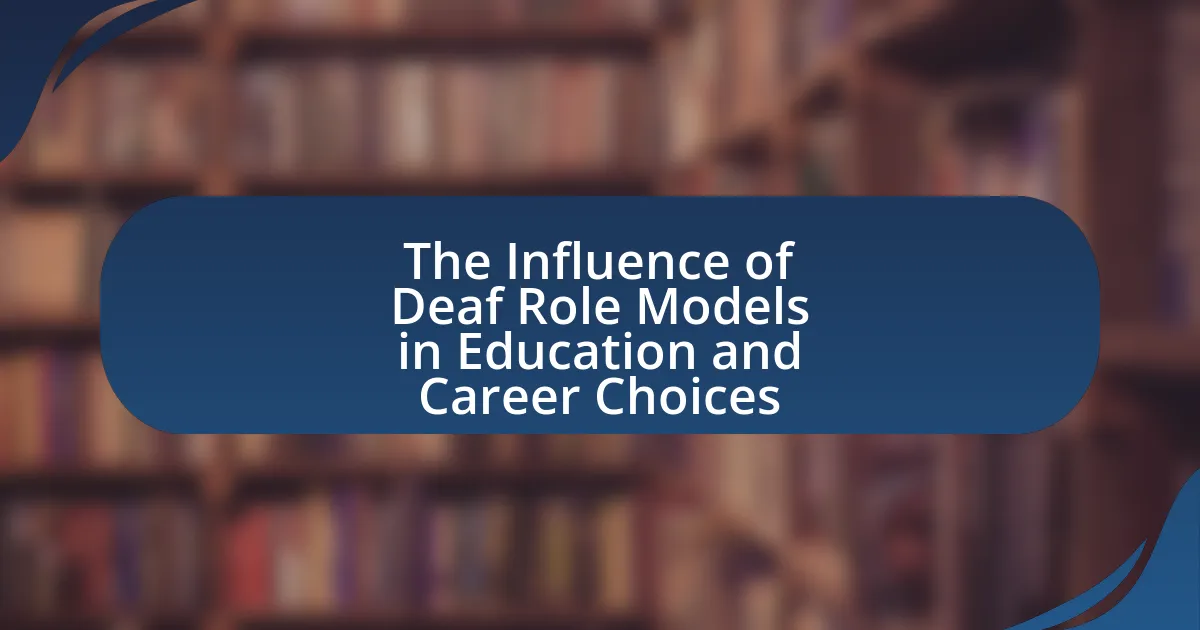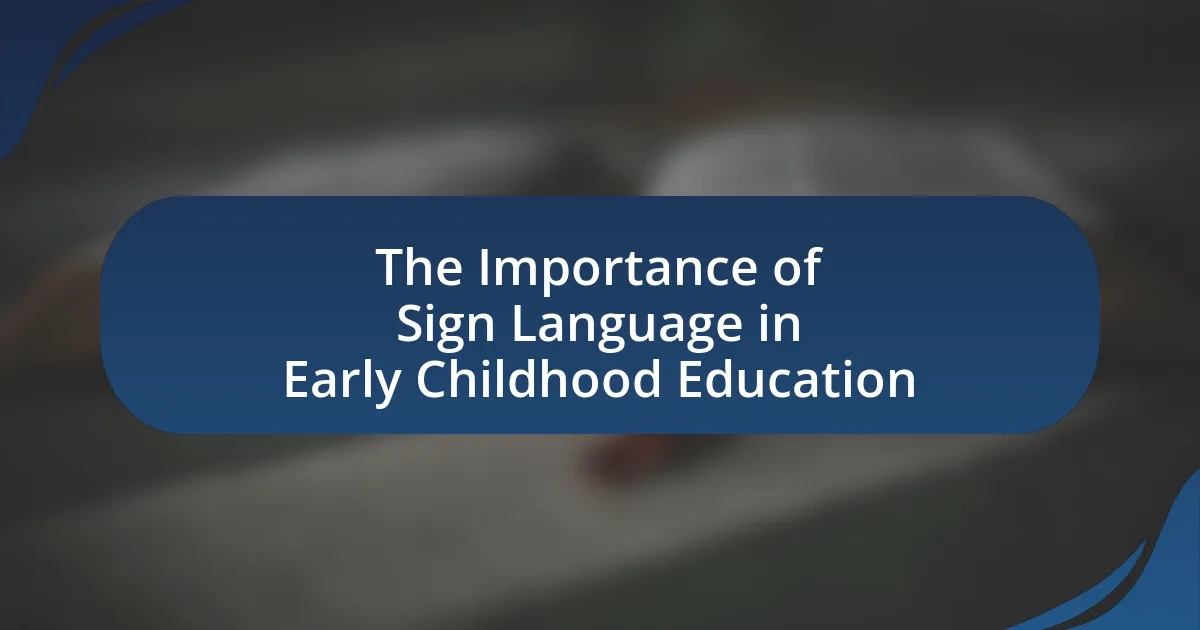The article “Bridging the Gap: Inclusive Teaching Strategies for Deaf Students” focuses on effective teaching methods that enhance the educational experience for deaf students. It outlines inclusive strategies such as the use of visual aids, sign language, and collaborative learning techniques, which have been shown to improve academic performance and social integration. The article also addresses the challenges educators face in implementing these strategies, emphasizes the importance of understanding diverse learning needs, and highlights the role of collaboration in fostering an inclusive environment. Additionally, it discusses practical tips for creating supportive classroom cultures and the resources available to assist educators in meeting the unique needs of deaf students.
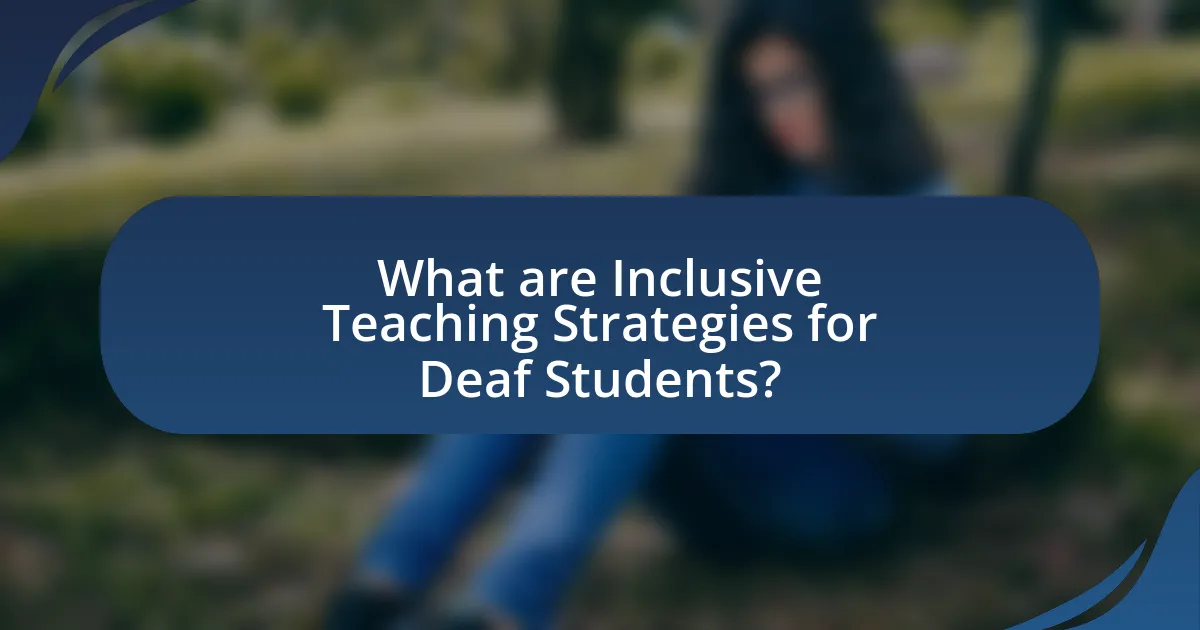
What are Inclusive Teaching Strategies for Deaf Students?
Inclusive teaching strategies for deaf students include the use of visual aids, sign language, and collaborative learning techniques. Visual aids, such as charts and videos, enhance comprehension by providing context and supporting information visually. Incorporating sign language into instruction facilitates communication and ensures that deaf students can engage fully with the material. Collaborative learning techniques, such as group projects, promote interaction among students, allowing deaf students to learn from their peers and develop social skills. Research indicates that these strategies improve academic performance and social integration for deaf students, as evidenced by studies showing increased engagement and understanding in inclusive classrooms.
Why is it important to implement inclusive teaching strategies for deaf students?
Implementing inclusive teaching strategies for deaf students is crucial because it ensures equitable access to education and promotes their academic success. Inclusive strategies, such as the use of sign language interpreters and visual aids, facilitate effective communication and engagement in the learning process. Research indicates that when deaf students are taught in inclusive environments, they demonstrate improved social skills and higher academic achievement compared to those in segregated settings. For instance, a study published in the Journal of Deaf Studies and Deaf Education found that inclusive practices significantly enhance the educational outcomes for deaf students, highlighting the importance of adapting teaching methods to meet diverse needs.
How do inclusive strategies impact the learning experience of deaf students?
Inclusive strategies significantly enhance the learning experience of deaf students by fostering an environment that accommodates diverse communication needs. These strategies, such as the use of sign language interpreters, visual aids, and collaborative learning, enable deaf students to engage more fully with the curriculum. Research indicates that when inclusive practices are implemented, deaf students demonstrate improved academic performance and social interaction, as evidenced by a study published in the Journal of Deaf Studies and Deaf Education, which found that inclusive classrooms lead to higher levels of participation and lower feelings of isolation among deaf students.
What challenges do educators face when implementing these strategies?
Educators face several challenges when implementing inclusive teaching strategies for deaf students, primarily due to communication barriers, lack of resources, and insufficient training. Communication barriers arise from the diverse language needs of deaf students, which can complicate lesson delivery and student engagement. Additionally, many educators lack access to specialized resources, such as sign language interpreters or appropriate technology, which are essential for effective instruction. Furthermore, inadequate training in deaf education and inclusive practices often leaves educators unprepared to meet the unique needs of deaf students, leading to ineffective teaching strategies. These challenges hinder the successful implementation of inclusive practices, ultimately affecting the educational outcomes for deaf students.
What are the key principles of inclusive education for deaf students?
The key principles of inclusive education for deaf students include accessibility, individualized support, and collaborative learning environments. Accessibility ensures that deaf students have equal access to educational resources, including sign language interpreters and visual aids, which facilitate communication and comprehension. Individualized support involves tailoring educational strategies to meet the unique needs of each deaf student, recognizing their diverse backgrounds and learning styles. Collaborative learning environments promote interaction among all students, fostering social inclusion and enhancing peer relationships. Research indicates that inclusive practices lead to improved academic outcomes and social skills for deaf students, as highlighted in the study “Inclusive Education for Deaf Students: A Review of the Literature” by McCracken and McGowan, published in the Journal of Deaf Studies and Deaf Education.
How does understanding diverse learning needs contribute to inclusivity?
Understanding diverse learning needs contributes to inclusivity by enabling educators to tailor their teaching methods to accommodate various learning styles and abilities. This tailored approach ensures that all students, including those with disabilities such as deafness, receive equitable access to education. Research indicates that inclusive classrooms, where diverse learning needs are recognized and addressed, lead to improved academic outcomes and social integration for all students. For instance, a study published in the “Journal of Special Education” found that students in inclusive settings demonstrated higher engagement and collaboration skills, highlighting the positive impact of understanding and addressing diverse learning needs on overall classroom inclusivity.
What role does collaboration play in creating an inclusive environment?
Collaboration is essential in creating an inclusive environment as it fosters diverse perspectives and shared responsibility among educators, students, and families. When individuals work together, they can identify and address barriers to inclusion, ensuring that all voices, particularly those of deaf students, are heard and valued. Research indicates that collaborative teaching models, such as co-teaching, enhance learning outcomes for students with disabilities by promoting tailored instructional strategies and peer support. For instance, a study published in the “Journal of Special Education” by Friend and Cook (2013) highlights that collaborative approaches lead to improved academic performance and social integration for students with diverse needs. Thus, collaboration not only enriches the educational experience but also cultivates a sense of belonging and community within inclusive settings.
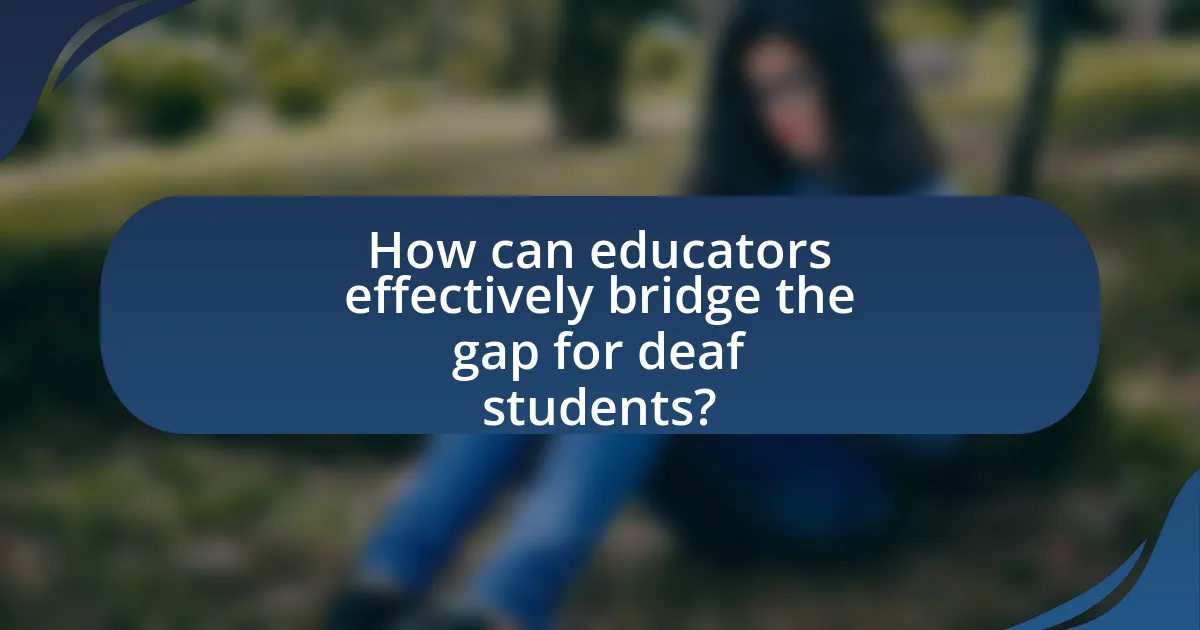
How can educators effectively bridge the gap for deaf students?
Educators can effectively bridge the gap for deaf students by implementing inclusive teaching strategies that prioritize visual learning and communication access. Utilizing sign language interpreters, providing written materials, and incorporating visual aids can enhance comprehension and engagement. Research indicates that deaf students perform better in environments where teachers use visual supports and foster a culture of inclusion, as demonstrated in studies by the National Deaf Center on Postsecondary Outcomes, which highlight the importance of tailored educational approaches for deaf learners.
What specific teaching methods are effective for deaf students?
Effective teaching methods for deaf students include the use of visual aids, sign language, and interactive learning techniques. Visual aids, such as charts and videos, enhance comprehension by providing clear, visual representations of concepts. Sign language serves as a primary mode of communication, allowing deaf students to engage fully with the material and participate in discussions. Interactive learning techniques, such as group activities and hands-on projects, foster collaboration and reinforce learning through practical application. Research indicates that these methods significantly improve academic performance and social interaction among deaf students, as evidenced by studies showing higher engagement and retention rates when visual and interactive strategies are employed.
How can visual aids enhance learning for deaf students?
Visual aids enhance learning for deaf students by providing essential visual information that compensates for the lack of auditory input. These aids, such as diagrams, charts, videos, and images, facilitate comprehension and retention of complex concepts, making learning more accessible. Research indicates that visual learning strategies can improve academic performance; for instance, a study published in the Journal of Deaf Studies and Deaf Education found that students who utilized visual aids scored significantly higher on assessments compared to those who did not. This demonstrates that visual aids are crucial in creating an inclusive educational environment for deaf students, enabling them to engage with and understand the material effectively.
What role does technology play in supporting deaf students’ education?
Technology plays a crucial role in supporting deaf students’ education by providing tools that enhance communication, accessibility, and learning engagement. For instance, assistive technologies such as hearing aids, cochlear implants, and real-time captioning services enable deaf students to access auditory information and participate in classroom discussions. Additionally, educational software and applications designed for deaf learners facilitate interactive learning experiences, allowing for personalized instruction and improved comprehension. Research indicates that the use of technology in educational settings significantly increases academic performance and social interaction among deaf students, as evidenced by a study published in the Journal of Deaf Studies and Deaf Education, which found that technology integration led to higher engagement levels and better learning outcomes.
How can classroom environments be adapted for deaf students?
Classroom environments can be adapted for deaf students by implementing visual aids, ensuring clear sightlines, and utilizing technology such as captioning services. Visual aids, including charts, diagrams, and sign language interpreters, enhance comprehension by providing alternative means of information delivery. Clear sightlines are crucial; seating arrangements should allow deaf students to see the teacher and peers easily, facilitating communication. Additionally, technology like real-time captioning and video relay services supports access to spoken content, making lessons more inclusive. Research indicates that these adaptations significantly improve learning outcomes for deaf students, as they create an environment conducive to engagement and understanding.
What are the best practices for seating arrangements in inclusive classrooms?
The best practices for seating arrangements in inclusive classrooms involve strategically placing students to enhance communication and engagement. Arranging desks in a U-shape or circle promotes visibility and interaction among all students, facilitating better access for those who are deaf or hard of hearing. Additionally, positioning students with hearing impairments closer to the teacher and any visual aids ensures they can effectively participate in lessons. Research indicates that such arrangements can significantly improve learning outcomes for deaf students by fostering a more inclusive environment that encourages collaboration and reduces barriers to communication.
How can noise reduction strategies improve focus for deaf students?
Noise reduction strategies can significantly improve focus for deaf students by minimizing distractions in their learning environment. These strategies, such as soundproofing classrooms and using visual cues, create a more conducive atmosphere for concentration. Research indicates that reducing background noise enhances cognitive processing and information retention, which is crucial for deaf students who rely on visual learning methods. For instance, a study published in the Journal of Deaf Studies and Deaf Education found that quieter environments lead to better academic performance among deaf students, as they can engage more fully with visual materials and interactions without auditory distractions.
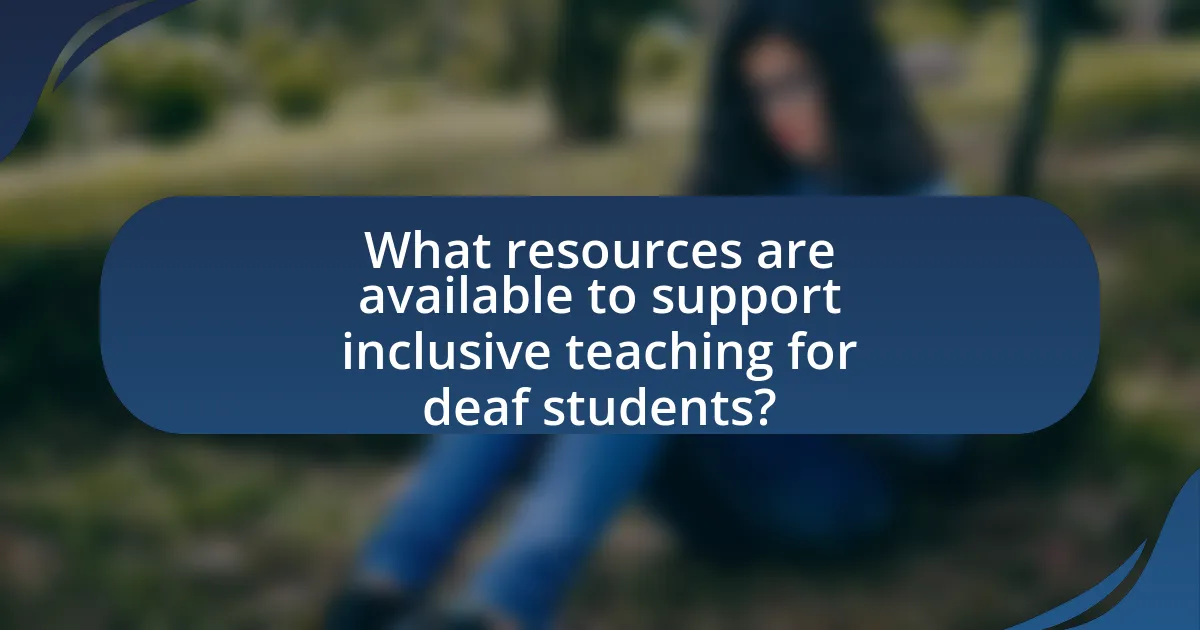
What resources are available to support inclusive teaching for deaf students?
Resources available to support inclusive teaching for deaf students include specialized educational materials, technology tools, and professional development programs. Specialized educational materials such as sign language dictionaries and visual aids enhance communication and comprehension. Technology tools like captioning software, video relay services, and hearing assistive devices facilitate access to information. Professional development programs for educators, such as workshops on deaf culture and inclusive teaching strategies, equip teachers with the skills necessary to create an inclusive classroom environment. These resources collectively contribute to effective teaching practices that accommodate the unique needs of deaf students.
What types of training and professional development are beneficial for educators?
Effective training and professional development for educators includes specialized workshops on inclusive teaching strategies, particularly for deaf students, as well as ongoing mentorship programs. Research indicates that educators who participate in targeted professional development are better equipped to implement effective teaching practices, leading to improved student outcomes. For instance, a study by the National Center for Learning Disabilities found that teachers who received training in specific strategies for deaf and hard-of-hearing students reported increased confidence and effectiveness in their teaching methods. Additionally, collaborative learning communities allow educators to share best practices and resources, further enhancing their skills in inclusive education.
How can educators access resources and materials tailored for deaf education?
Educators can access resources and materials tailored for deaf education through specialized organizations, online platforms, and educational institutions. Organizations such as the National Association of the Deaf and the American Speech-Language-Hearing Association provide extensive resources, including teaching materials and professional development opportunities. Online platforms like the Deaf Education Resources website offer a compilation of tools, lesson plans, and research articles specifically designed for deaf education. Additionally, universities with programs in deaf education often have libraries and resource centers that provide access to specialized materials and research. These avenues ensure that educators have the necessary support and resources to effectively teach deaf students.
What community organizations can assist in supporting deaf students and their families?
Community organizations that assist in supporting deaf students and their families include the National Association of the Deaf (NAD), which advocates for the rights of deaf individuals and provides resources for education and community engagement. Additionally, the Hearing Loss Association of America (HLAA) offers support groups and educational materials for families. The American Society for Deaf Children (ASDC) focuses on empowering families with deaf children through resources and networking opportunities. These organizations provide essential services such as advocacy, educational resources, and community support, which are crucial for the development and well-being of deaf students and their families.
What are some practical tips for implementing inclusive strategies in the classroom?
To implement inclusive strategies in the classroom, educators should utilize visual aids, incorporate sign language, and foster a supportive environment. Visual aids, such as charts and images, enhance comprehension for all students, particularly those who are deaf or hard of hearing. Incorporating sign language into lessons not only aids communication but also promotes inclusivity among hearing and non-hearing students. Creating a supportive environment involves encouraging peer collaboration and ensuring that all students feel valued and included, which has been shown to improve engagement and learning outcomes. Research indicates that inclusive classrooms lead to better academic performance and social skills for students with disabilities (Hehir et al., 2016, Harvard Education Press).
How can teachers foster a supportive and inclusive classroom culture?
Teachers can foster a supportive and inclusive classroom culture by implementing differentiated instruction and promoting collaboration among students. Differentiated instruction allows teachers to tailor their teaching methods to accommodate diverse learning needs, ensuring that all students, including those who are deaf, can engage with the material effectively. Research indicates that when teachers use varied instructional strategies, such as visual aids and hands-on activities, students demonstrate improved understanding and participation (Tomlinson, 2014). Additionally, promoting collaboration through group work and peer support encourages social interaction and builds a sense of community, which is essential for inclusivity. Studies show that inclusive classrooms, where students work together, lead to higher academic achievement and social skills development (Friend & Cook, 2013).
What strategies can be used to engage deaf students in group activities?
To engage deaf students in group activities, educators can implement visual communication strategies, such as using sign language interpreters and visual aids. These methods facilitate understanding and participation, allowing deaf students to interact effectively with their peers. Research indicates that incorporating visual elements, like charts and videos, enhances learning for deaf students, as they often rely on visual cues for information processing. Additionally, fostering an inclusive environment where all students are encouraged to use sign language and visual communication promotes collaboration and social interaction among group members.


